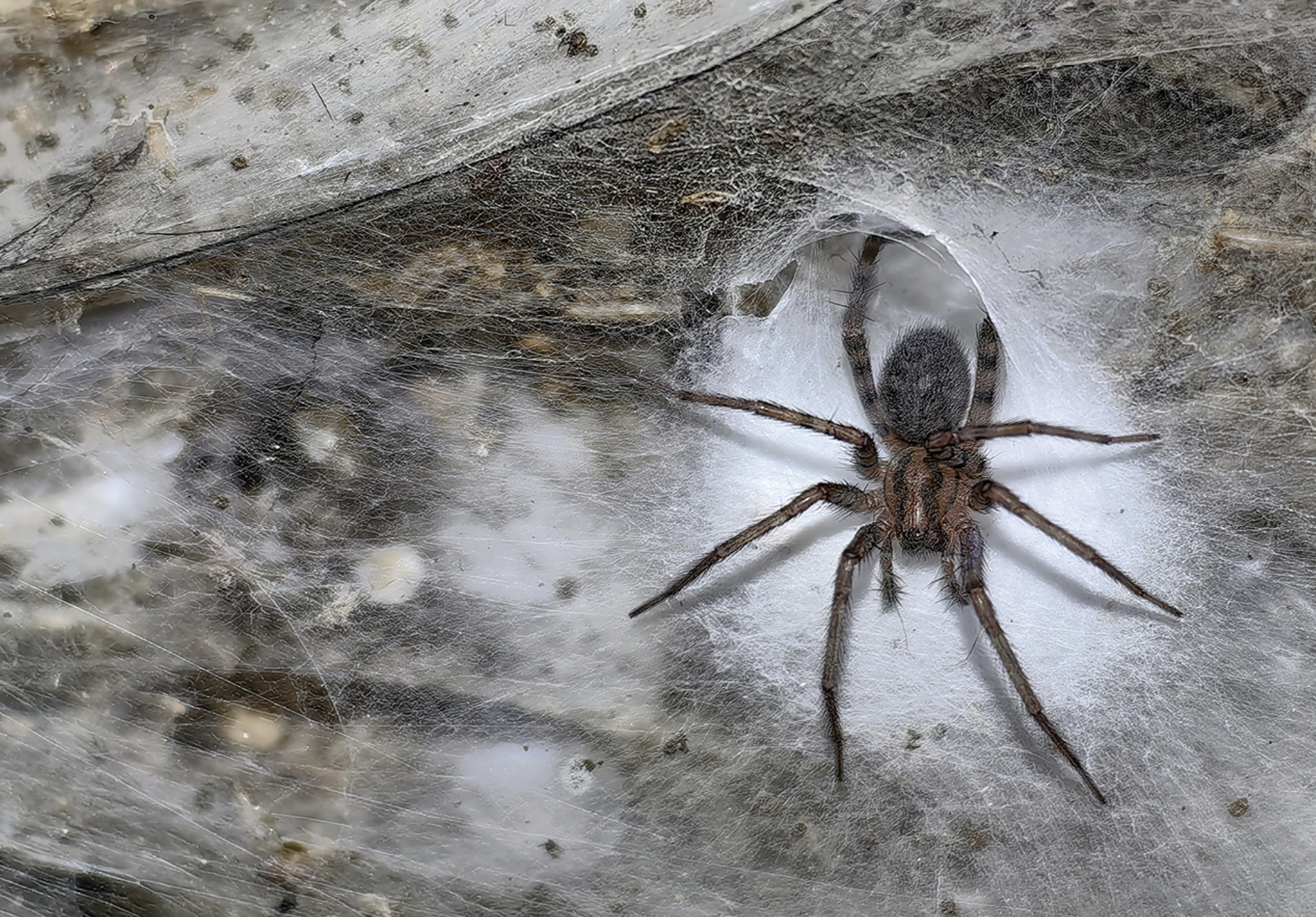After a brief foray into creatures big, flashy, and famous, we must return to form and focus on the spineless, creepy, and crawling. Today we're shining a spotlight on one of the most loathèd creepy-crawlers of all—the humble spider. You may fear them, what with their eight spindly legs and general can-do demeanor, but what if you found a little space in your heart, an open drawer or empty shelf, in which a small spider might find a home? Would not this small act of empathy expand the wonder and awe you felt the world offered you? Would not this simple act of grace make you feel a deeper connection to all creatures great and small?
If not, too bad! I've got two new spider web discoveries to share with you. We're talking spiders this month, and you're just going to have to deal. It is true that different spiders and their eclectic webs made it into the hallowed pages of Defector just last month, but such a coincidence does not detract in any way from the immediacy of these latest web-based discoveries. After all, what is a web for but to connect us all?
The World's Largest Spider Web
We should begin with the actually breaking news, which is that in 2022 scientists went spelunking in Sulfur Cave along the border of Albania and Greece and stumbled upon a spider web half the size of a tennis court, and is home to at least 111,000 spiders. The discovery, which was published recently in the journal Subterranean Biology, is remarkable. Not only does it represent a rare model of a harmonious group that we could certainly learn from, but it also represents the largest spider web in the world. I find this latter fact oddly reassuring, as it places a known upper limit on just how large a spider web has gotten. It's likely that there are larger webs out there, but the fact that we have not found them yet means I am less likely to encounter them in my day-to-day life.
When I first saw the headlines heralding the World's Largest Spider Web, I imagined some massive yet classical web with orderly strands. I was wrong, of course. The world's largest spider web is not one magnified web, but thousands and thousands of webs woven together into a monstrous, shimmering curtain that resembles a portal into some strange world that I hope never, ever to enter.
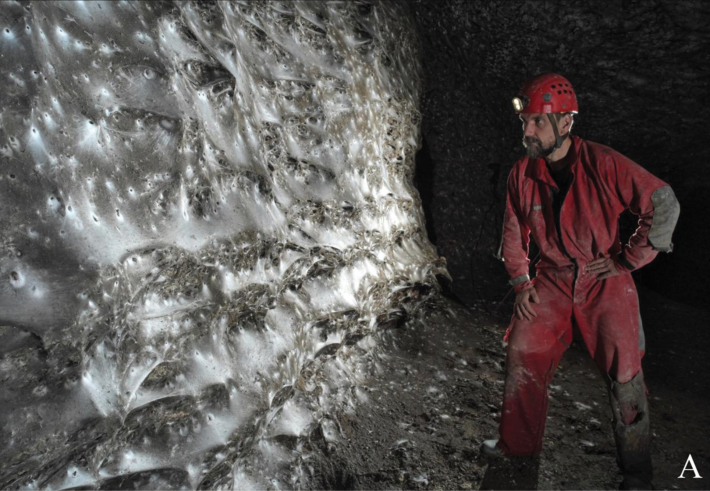
Many of my immediate questions about the Web were answered in this New York Times story, such as: What does it feel like? Spongy, as it is several layers thick. What does it smell like? Spoiled eggs, but this is due to the sulfide gas that permeates the cave, and is not the fault of the spiders. In fact, Sulfur Cave is located inside the Vromoner Canyon, which translates to "smelly water" in Greek. So it would have been surprising if the Web smelled good.
The spiders were not the only inhabitants of the cave, of course. Its inky waters swim with fish, worms, and the larvae of various beetles and midges. Its rocks crawl with centipedes, isopods, springtails, beetles, scorpions and pseudoscorpions. Sulfur Cave really does have it all. And the passage leading to the massive web has a guardian, or guardians, of sorts: a dense swarm of midges that fill the darkness like small and horrible stars.
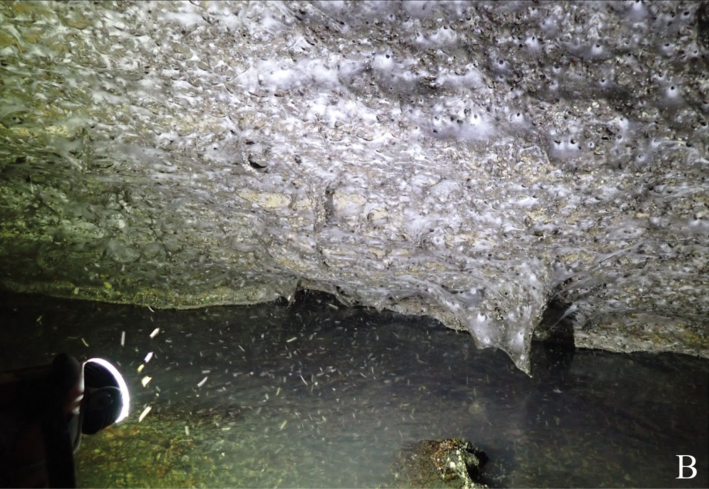
How many spiders dwell within the Web? They did not count them individually, but estimated that the structure contained 69,000 Tegenaria domestica spiders, which are also known as barn funnel weavers, and 42,000 Prinerigone vagans spiders, which are belong to a little-understood group of small spiders known as sheet weavers.
This was surprising for a whole host of reasons, firstly because the barn funnel weavers are known to eat the sheet weavers. But here in the dank solace of the cave, the two species lived in peace, which the scientists suspect is not due to any altruism on behalf of the barn funnel weavers but rather the fact that the pitch-black conditions of the cave make it difficult for the big spiders to detect the smaller ones.
Scientists have observed some spiders living in cooperative eight-legged societies in the tropics. Scientists have also observed one species of Goeldia cave-dwelling spider cooperating between individuals, but not at the scale of living in large, stable, and cooperative spider webs. The barn funnel weaver and the sheet weaver, however, are solitary spiders. So a spider co-op of this size, location, and species is truly remarkable.
I can only imagine what one might experience upon encountering the Web for the first time, what unprecedented cocktail of fear, respect, and insignificance would wash over me as I stood face-to-face with that many spiders and that much silk. When the scientists shined their lights onto the webbed mass, it sparkled. "If I were to attempt to put into words all the emotions that surged through me [when I saw the web], I would highlight admiration, respect, and gratitude. You have to experience it to truly know what it feels like," István Urák, a biologist at Sapientia Hungarian University of Transylvania in Romania, told Live Science. Perhaps this could be next Defector Tip Jar Sweepstakes: Join me and Barry as we confront the formidable unknown of the Smelly Web. What might we discover?
Fake Spiders In Webs
We turn now to another tale of spider ingenuity, this time in the family of orb-weaving spiders famed for the decorations they incorporate into their webs, known as stabilimenta. Scientists still do not entirely understand the purpose of these embellishments, which may ward off predators, deter birds from flying through the webs, or even attract prey. But a new paper in Ecology and Evolution describes a very high concept form of stabilimenta woven by two species of orb-weavers found in the tropical forests of the Philippines and Peru.
These spiders create enormous spider-shaped decoys, almost like scarecrows, to fool potential predators. These decoys are woven from silk and built from the dead bodies of their prey and also miscellaneous plants. One of the authors, George Olah from the Australian National University, calls it a "theater of deception." Olah is right. What cunning, Machiavellian spiders! If I were to walk by one such web, perhaps at a slight distance, their handiwork would certainly fool me. "Oh my!" I might say, upon glimpsing such an enormous spider. "I shan't be walking that way, no sirree!"
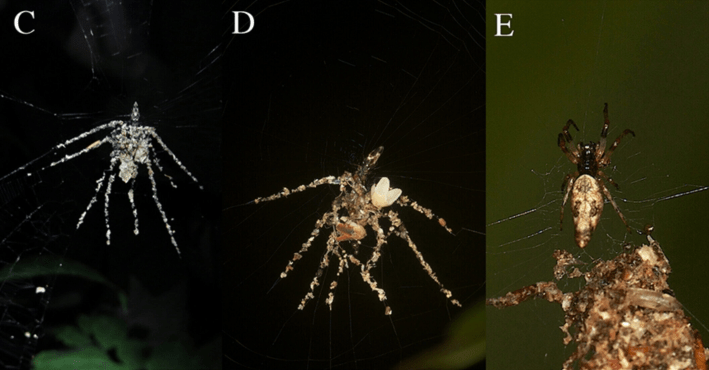
The researchers first noticed these spider scarecrows in 2012, when they were surveying the plants growing by trails in the Tambopata National Reserve in the Peruvian Amazon and the trails around Mount Kanlaon Natural Park on the Island of Negros in the Philippines. The first decoy the researchers saw in the Philippines had eight perfect "legs" radiating outward from the clump of the body. And the first decoy the researchers saw in Peru tricked them completely; they mistook it for a spider killed by a fungus.
There are only two other scientific records describing a similar practice in other spider species, one of which, Cyclosa morretes, did not seem to be very skilled at all, with stanbilimentum that amounted to "a blob with extensions resembling legs," the authors write. By comparison, the Cyclosa spiders in the new paper all build genuinely convincing decoys. Their decoys have between four to eight legs, all extending from a larger body. These Cyclosa spiders have standards. They will not settle for any old blob body. They have predators to trick, eggs to tuck away, and young spiderlings to conceal. Some spiderlings even hid themselves within the decoy.
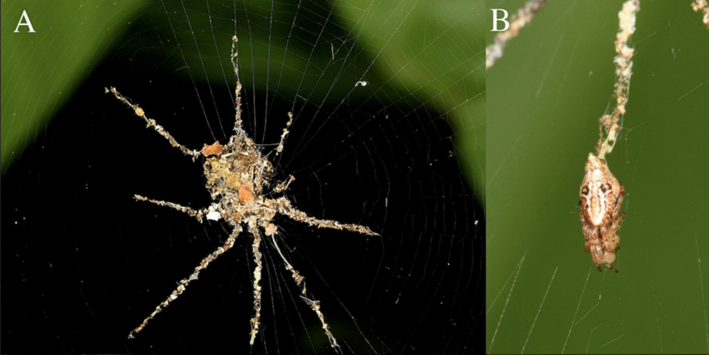
In 2022, the researchers encountered 20 Cyclosa spiders in the Peruvian Amazon. When they shone a flashlight on the webs, the spiders shook their abdomens against the silk, making their giant spider decoys shake. Again, this sleight of leg would certainly work on me. A giant spider wobbling in and out of my face? I'm skedaddling! If you want to get a better sense of what it's like to encounter one of these webs at night, the researchers made a short video that takes you into Peru so that you, too, can feel like you were there with them in the Amazon with Dakota Johnson's mom researching spiders right before she died.
The researchers, however, were cautious to offer multiple potential explanations for the decoys. The giant spiders might deflect the attacks of predators and camouflage the spider, of course, but the downward-pointing decorations might also mimic dripping bird shit to deter birds, which, I am pleased to have learned, do not want to eat their own shit. Either way, the scientists noticed that the spiders who build these giant decoys tend to be more sedentary than other spiders that build simpler webs. If you are always on the move and needing to rebuild your web, perhaps you would not bother recreating such a masterpiece each time. Anyone who has ever moved understands this.
The scientists do not suggest that the decoys could be purely decorative, because this explanation would make little evolutionary sense given the time and effort that goes into crafting such an imposing figure. But of course nature is full of surprises and we cannot rule anything out. Is a spider not allowed to have hobbies? Would a spider not make a killing selling these giant replicas of herself to zillennials on Itsy (it's like Etsy but for spiders)? In a world where these decoys were indeed purely decorative, perhaps we as animals are united across species by the desire to display a giant replica of ourselves after death outside our homes to entertain the masses while we sit back on the comfort of our porch and pray that we never have to move again.
